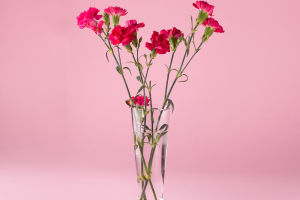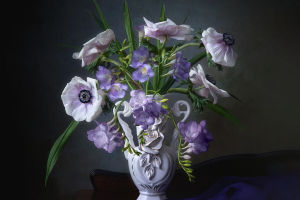Flower arrangement is a form of artistic expression with a long history. It combines the power of aesthetics and nature, showing the delicate relationship between humans and plants.
Flower arrangement is not just a decoration; it is also a way to convey emotions and philosophy through form, color, and sense of space.
The art of flower arrangement in different cultures has its characteristics. From the Japanese "Ikebana" to Western flower design, each system possesses unique concepts and techniques, which makes this art form widely appealing around the world. In China, flower arrangement has a history of more than 2,000 years. In ancient China, flower arrangement was listed as one of the four elegant pursuits along with painting, calligraphy, and the tea ceremony, and it was an essential part of the lives of literati.
Chinese flower arrangement emphasizes nature, harmony, and simplicity, advocating for a fresh and elegant style. Flowers are typically selected from traditional favorites such as plum blossoms, orchids, bamboo, and chrysanthemums to highlight the changes of the four seasons and the power of nature. The art of flower arrangement in China embodies the philosophical idea of "harmony between man and nature," emphasizing the harmonious coexistence of humans and nature.
In contrast, Japan's flower arrangement art—Ikebana—pursues simplicity, elegance, and artistic conception. Ikebana is not merely a flower arrangement technique but a way of life that cultivates one's character and sentiment through flower arrangement. It emphasizes "spatial beauty" and highlights the natural beauty of flowers through careful spatial arrangement.
How I Build a Flower Arrangement! 🌿✂️🌼// Garden Answer
Video by Garden Answer
In Japan, each element in the flower arrangement holds a special symbolic meaning. For example, pine trees symbolize longevity, chrysanthemums represent nobility, and bamboo symbolizes tenacity and fortitude. Japanese flower arrangement art seeks to express complex emotions through simple design, with the works often conveying a tranquil and far-reaching state of mind through a quiet and profound atmosphere.
Western flower arrangement art differs significantly from its Eastern counterpart, reflecting a pursuit of complex and symmetrical aesthetics. In Europe, flower arrangement art emerged during the Renaissance, influenced by painting and sculpture, focusing on color matching and symmetry of form. Western flower arrangements are often more magnificent, featuring a variety of floral materials. Roses, lilies, tulips, and other colorful and graceful flowers are common protagonists. Western flower arrangements emphasize visual impact, creating a sense of luxury through rich colors and tight compositions. Compared to the natural and simple style of Eastern flower arrangements, Western flower arrangement art pays more attention to visual splendor and the decorative function of flowers.
However, despite the vast differences in the styles of Eastern and Western flower arrangements, they both reflect the common pursuit of natural beauty by human beings. Whether it is the simple beauty of the East or the complex beauty of the West, flower arrangement art expresses inner emotions and philosophy through the natural posture of flowers. The uniqueness of this art form lies in its ability to give static flowers new life and meaning through clever arrangement and combination.
With the changes of the times, modern flower arrangement art continues to innovate and develop while retaining traditional styles.
Contemporary flower arrangement artists often break traditional forms and rules, incorporating more materials and elements such as stone, wood, and metal, thus pushing flower arrangement art into a more diversified and cross-border integration realm. Modern flower arrangement is no longer limited to traditional vase arrangements; it has gradually developed into installation art. The combination of flower design with architecture, fashion, photography, and other fields is becoming increasingly close, allowing flower arrangement art to occupy an important position in contemporary art.
In daily life, flower arrangement is not only an elegant art form but also gradually becomes an important part of home decoration. Flower arrangements can bring a natural breath and vitality to the space, improve the quality of life, and have a certain psychological healing effect.
Studies have shown that contact with nature and flowers can relieve stress and improve mood, which is one of the reasons flower arrangement is highly regarded in contemporary life.







